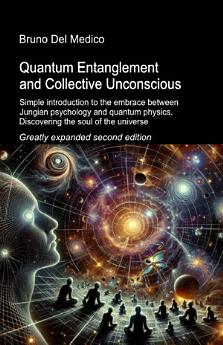Quantum Entanglement and Collective Unconscious. Greatly expanded second edition: Simple introduction to the embrace between Jungian psychology and quantum physics. Discovering the soul of the universe
关于此电子书
Enigmatic coincidences and invisible connections between events and people have fascinated humankind since time immemorial. Think, for example, of that strange feeling of "knowing something" even before it happens. Or that dream that foreshadows a real event. Or the sudden perception of danger that leads to the avoidance of a tragedy. There are those who speak of intuition, those who speak of synchronicity. And there are those who try to tie these unexplained experiences to science.
On the one hand, quantum entanglement. On the other, collective unconscious. The invisible world of the physical universe and the depths of the human mind may actually be more connected than we imagine.
Quantum entanglement is one of the most enigmatic phenomena in modern physics. Take two particles that interact for a brief instant and then separate. Despite the distance, they remain miraculously "tuned in": any change in the state of one particle is immediately reflected in the other, even kilometers - or light-years - away.
What if this kind of connection is not only about particles but also about human beings? Modern psychology has tried to answer, using different but equally fascinating tools. Carl Gustav Jung, the great Swiss psychoanalyst, intuited the existence of a mental connection that goes beyond individuality. In his work on the collective unconscious, Jung described a psychic dimension shared by all human beings, a subtle network of archetypes and universal symbols. Jung observed that people experience what he called "synchronicities," that is, events that are significantly related but seem to have no apparent common cause. Wolfgang Pauli, one of the fathers of quantum physics, shared Jung's interest in synchronicities.
These ideas have found new shores in the thinking of contemporary physicists. Amit Goswami, a quantum physics theorist, hypothesized that the human mind and the subatomic world share the same "fabric." The mind, according to this view, constantly interacts with physical reality, creating events that we perceive as extraordinary. The similarity between quantum entanglement and the collective unconscious has also sparked debates among philosophers. Physicist Fritjof Capra, in his book "The Tao of Physics," explored the parallels between ancient Eastern traditions and modern physics. Taking his cue from the concept of interconnectedness, Capra suggests that the universe is a giant network of relationships, where each element is inextricably linked to the others. This view comes close to the Jungian idea that humanity shares not only a common psychic heritage, but also a connection to the fundamental structure of the world. Premonitions, coincidences and dreams thus seem to become visible traces of this infinite network.
Whether we are talking about quantum particles or the human mind, one question remains open: why do these mysterious links exist? Science has just begun to scratch the surface of this question. But what emerges is a fascinating picture: that of a universe made up of relationships rather than objects. Every thought, every dream could be an atom of this universal network.
This volume is the second edition of a short text already published under the same title in 2016. The content has been greatly expanded, which has resulted in more than a doubling of pages, according to readers' requests and according to the needs arising from the development of scientific theories.
Reader comments.
A nimble, easy-to-read booklet that combines synthesis and depth, enriching the reader's knowledge in a short time.
A compact work that makes complexity accessible through clarity and stylistic immediacy.
A slim and comprehensive book that offers valuable content in a light and inspiring format.
A short but comprehensive text, perfect for quickly delving into complex topics without superficiality.
A small volume that combines simplicity, precision and an extraordinary capacity for synthesis.
作者简介
Bruno Del Medico, born in 1946 in Sabaudia, Italy, during his working life has been involved in computer science and software development. Later he devoted himself to the study and popularization of the most current scientific theories, such as quantum theory in its metaphysical meaning. Currently Bruno Del Medico is the author of numerous works published in PensareDiverso Editions. Bruno Del Medico's work differs from traditional narratives in the field of technical sciences in its critical, independent and unconventional approach. Instead of limiting himself to standard interpretations or general consensus on purely scientific issues, Bruno Del Medico explores alternative perspectives that often go against the grain, questioning commonly accepted assumptions. A distinctive feature of his works is his ability to weave science, ethics and philosophy into an open dialogue that encourages the reader to reflect independently and consider the deeper implications of technological and scientific innovations.






